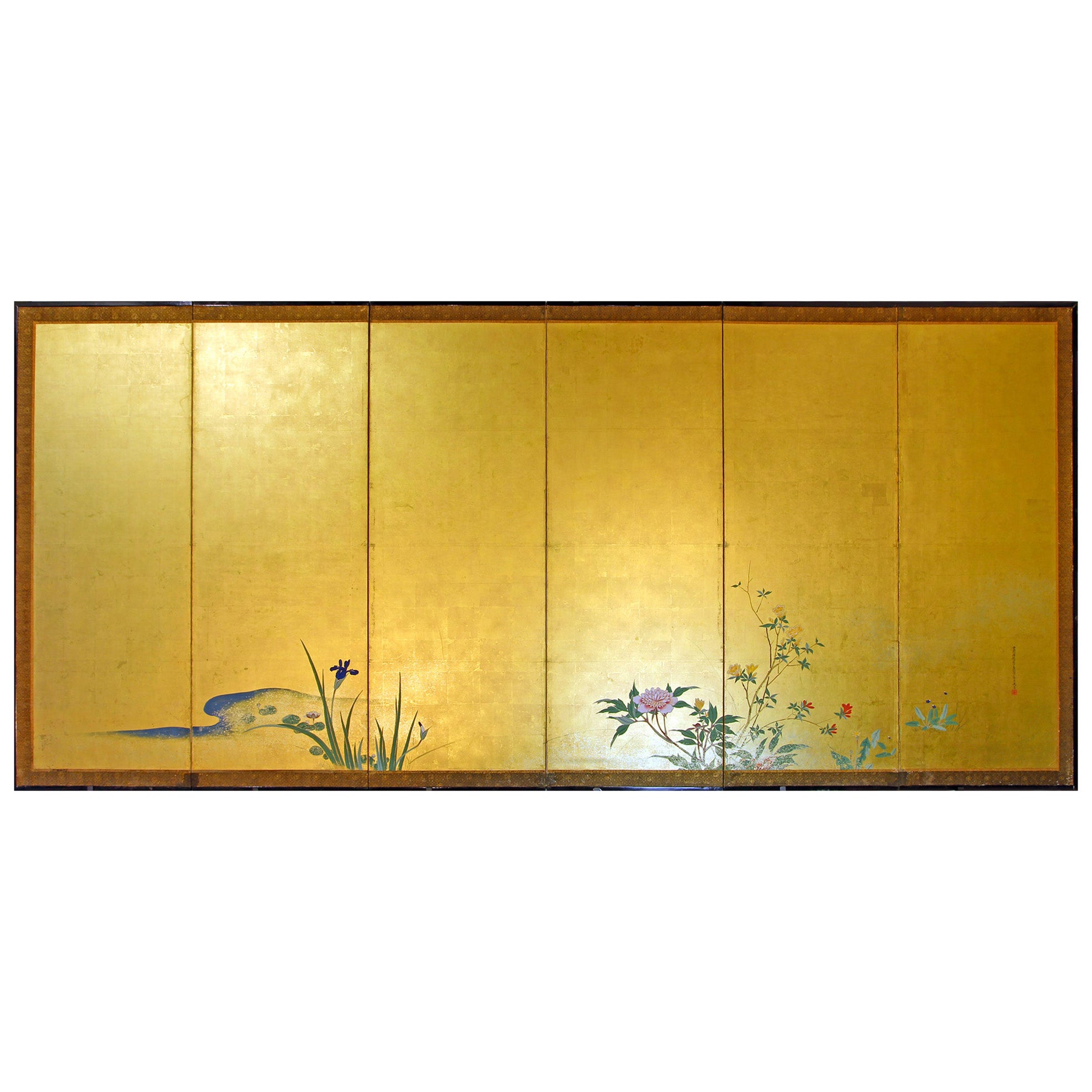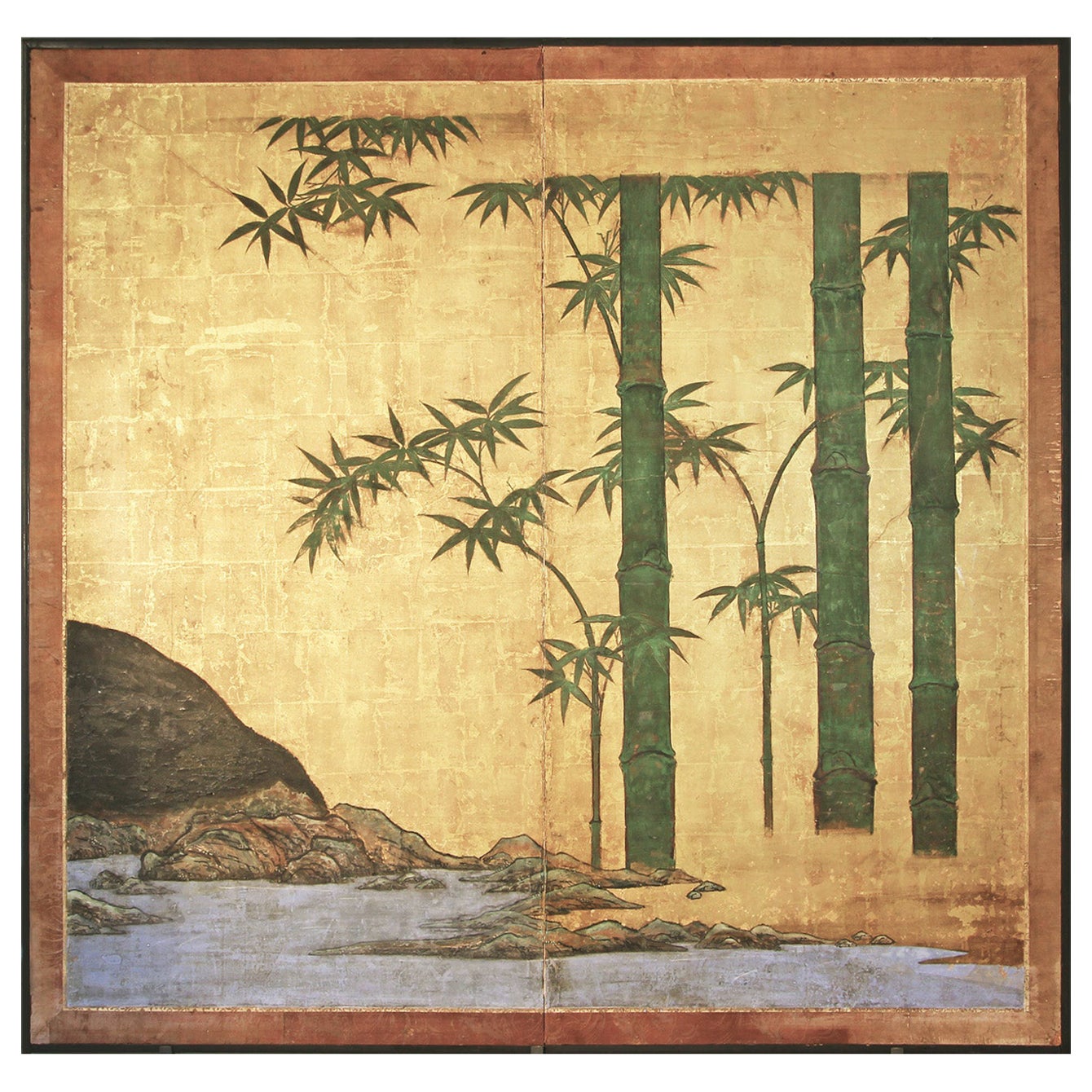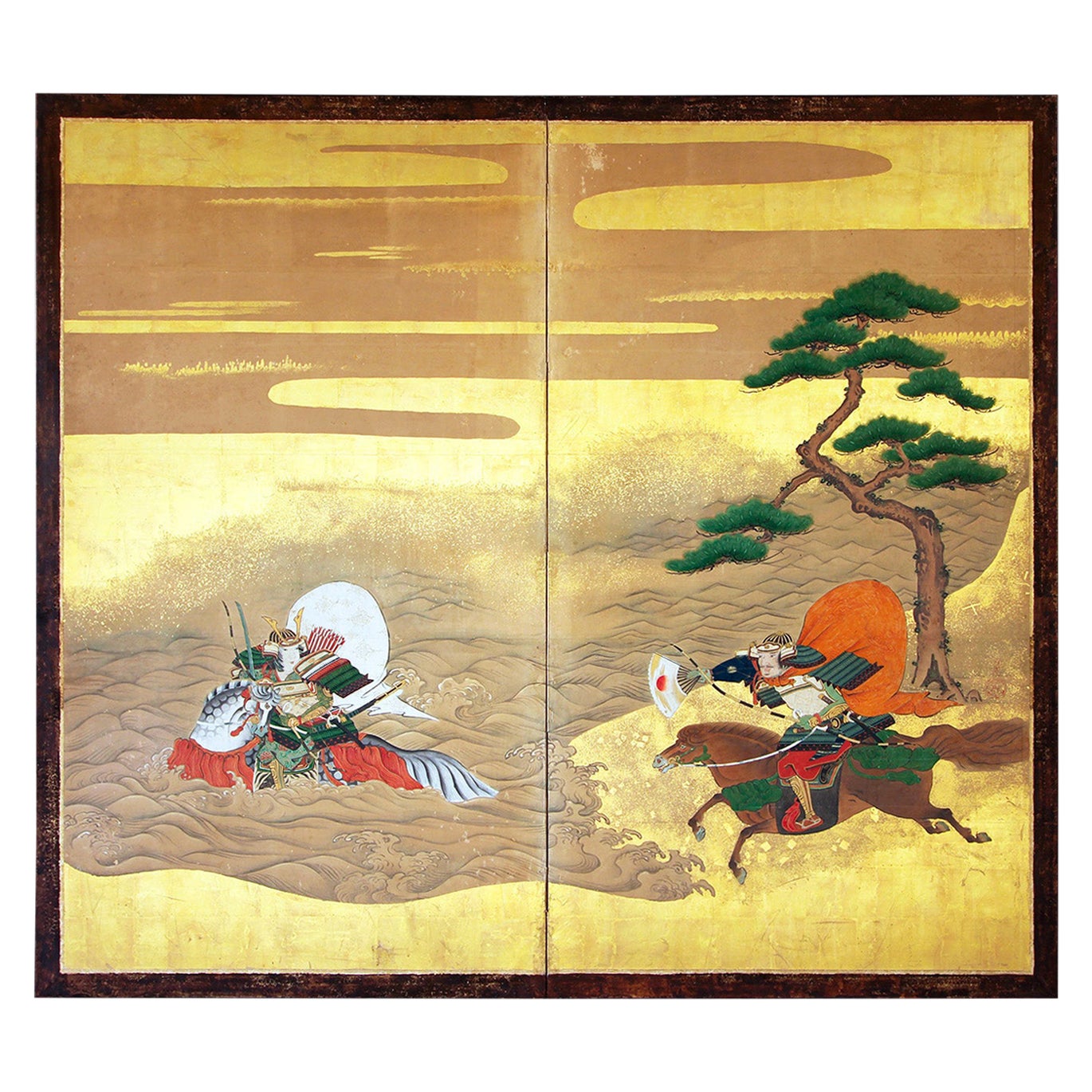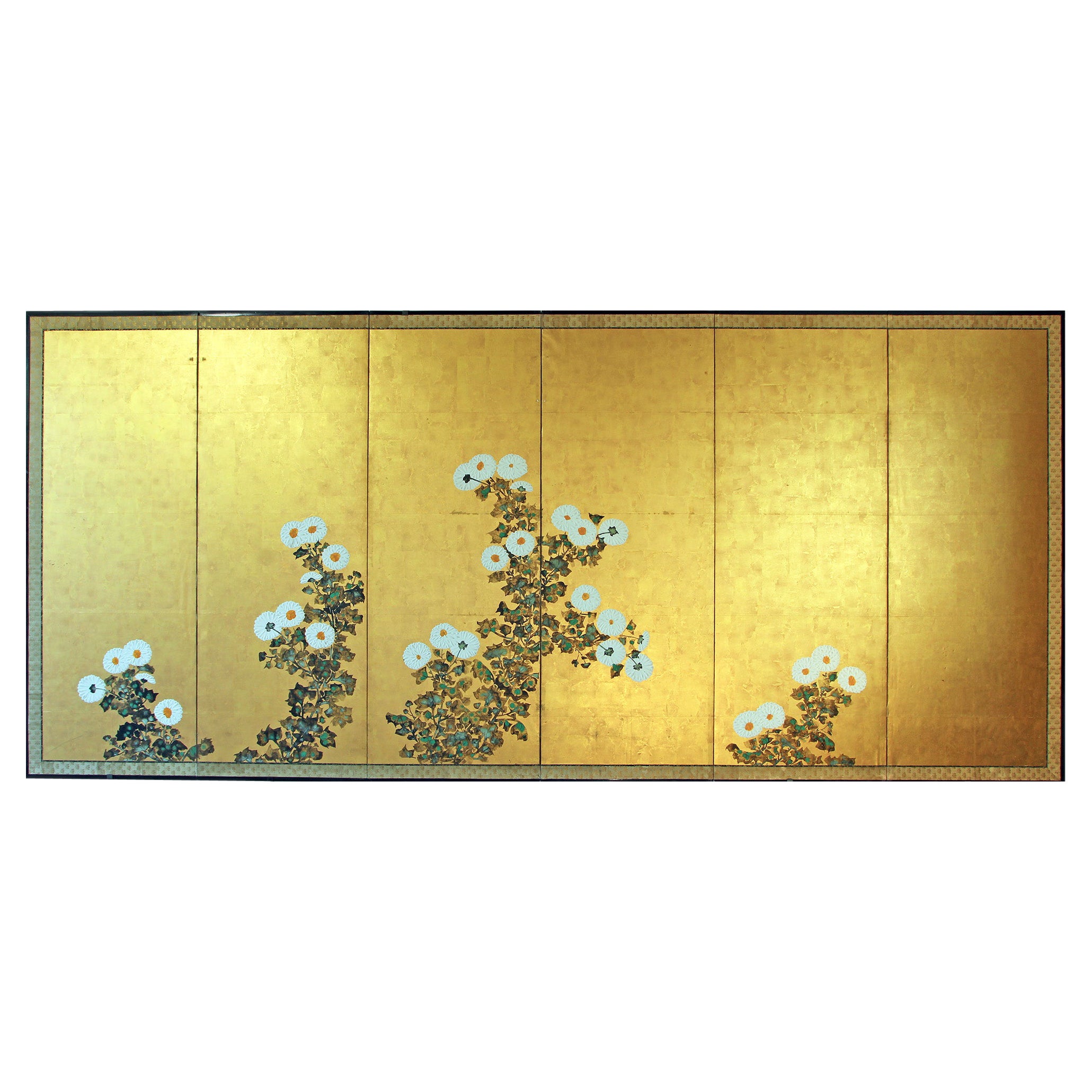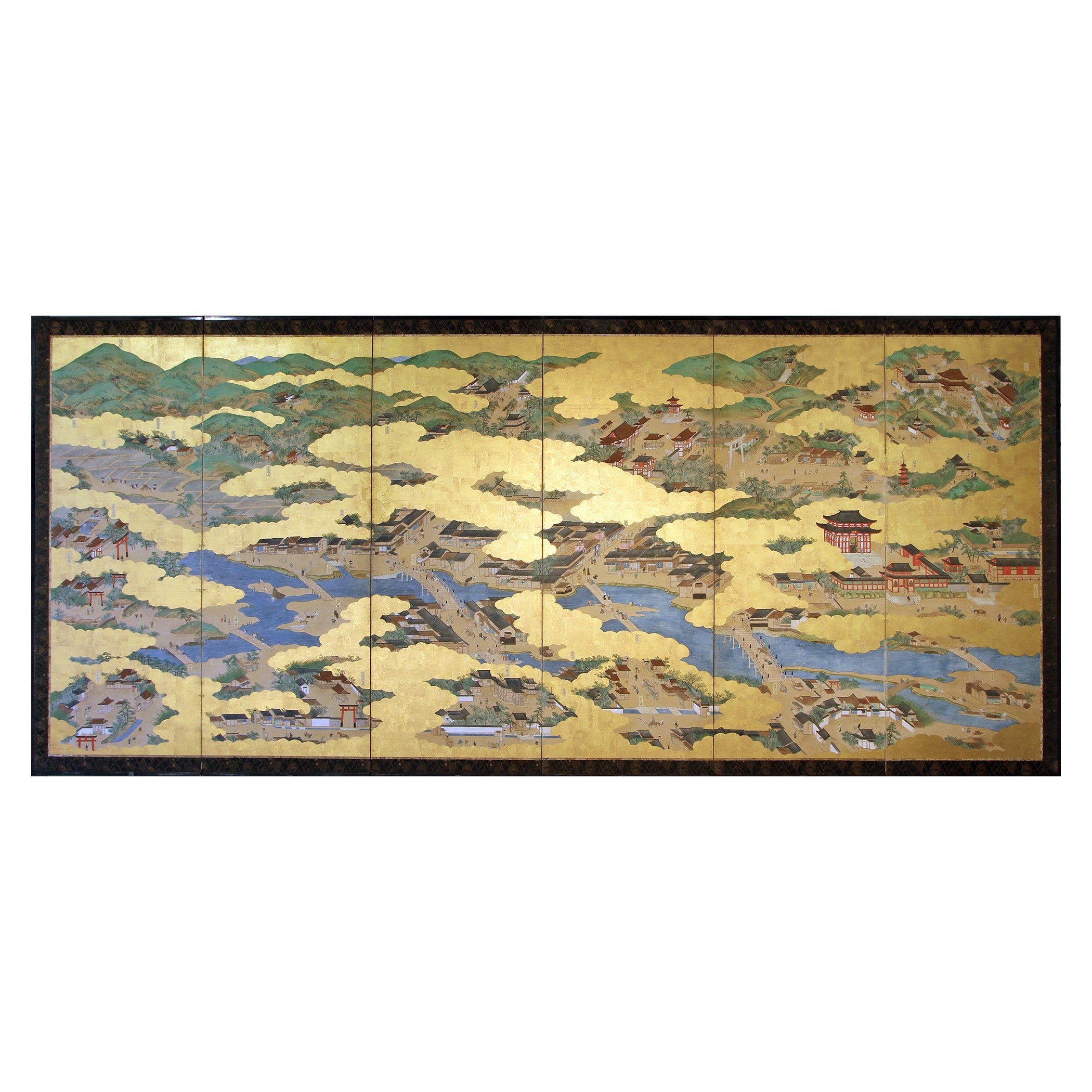Items Similar to Paravento Giapponese a due pannelli
Want more images or videos?
Request additional images or videos from the seller
1 of 6
Paravento Giapponese a due pannelli
About the Item
Sempre alla ricerca di cose particolari abbiamo acquistato questo paravento giapponese da una collezionista di Osaka.
Un esempio di arte del novecento che si ispira alla scuola di Kano.
Due pannelli dipinto a pigmenti minerali su carta dorata, esso risulta essere ben proporzionato non ha difetti ed è ben conservato.
- Creator:Japanese Studio (Artist)
- Dimensions:Height: 60.63 in (154 cm)Width: 59.85 in (152 cm)Depth: 0.79 in (2 cm)
- Style:Showa (Of the Period)
- Materials and Techniques:
- Place of Origin:
- Period:
- Date of Manufacture:1959 circa
- Condition:Wear consistent with age and use.
- Seller Location:Brescia, IT
- Reference Number:1stDibs: LU5628238036362
About the Seller
5.0
Recognized Seller
These prestigious sellers are industry leaders and represent the highest echelon for item quality and design.
Established in 1981
1stDibs seller since 2021
14 sales on 1stDibs
Typical response time: 4 hours
- ShippingRetrieving quote...Ships From: Brescia, Italy
- Return PolicyA return for this item may be initiated within 10 days of delivery.
More From This SellerView All
- Paravento giapponese a sei pannelli dipinto su foglia d'argentoBy Japanese StudioLocated in Brescia, ITPaesaggio giapponese: paravento a sei pannelli dipinto a pigmenti minerali su foglia d'argento. Elegante e moderno esempio di arte orientale senza figure uccelli o fiori. Paravento b...Category
Mid-20th Century Japanese Showa Paintings and Screens
MaterialsSilver Leaf
- Paravento Giapponese a sei pannelli su foglia d'oro.By Japanese StudioLocated in Brescia, ITParavento giapponese a sei pannelli , opera di un pittore della prima metà del 19° secolo, di scuola Rinpa. Sei pannelli dipinti con inchiostro su foglia oro e "gofun" su carta veget...Category
Antique Early 19th Century Japanese Edo Paintings and Screens
MaterialsGold Leaf
- Paravento Due Pannelli Bambù su Foglia d'OroBy Japanese StudioLocated in Brescia, ITPaesaggio giapponese della sciuola di Kano dei primi anni del XVIII° secolo a due pannelli con alberi di bambù. Pigmenti minerali e foglia d'oro su carta vegetale. Bordo in seta ne b...Category
Antique Early 18th Century Japanese Edo Paintings and Screens
MaterialsGold Leaf
- Paravento Giapponese SamuraiBy Japanese StudioLocated in Brescia, ITParavento a due pannelli di scuola Tosa dipinto a pigmenti minerali su foglia d'oro e carta di riso. Raffigura nella Guerra di Genpei la Battaglia di Ichi-no-Tani tra i Clan Giappone...Category
Antique 18th Century Japanese Edo Paintings and Screens
MaterialsGold Leaf
- Paravento Giapponese - Foglia d'oroBy Japanese StudioLocated in Brescia, ITPaesaggio primaverile di ignoto pittore della scuola Rinpa, XIX secolo, inchiostro a sei pannelli dipinto su foglia oro su carta di riso. I fiori sono realizzati con la tecnica del "...Category
Antique Mid-19th Century Japanese Edo Paintings and Screens
MaterialsGold Leaf
- Tosa School, paravento giapponese, paesaggio della città vecchia di KyotoBy Japanese StudioLocated in Brescia, ITDel periodo Edo questo grande paravento giapponese che riproduce l'antica città di Kyoto e i suoi sobborghi. Dipinto con inchiostri e pigmenti minerali, fin nei minimi dettagli su ca...Category
Antique Early 19th Century Japanese Edo Paintings and Screens
MaterialsGold Leaf
You May Also Like
- Japanese Modernist Painting of a Seaside Village by Torao Ataka Dated 1930By Japanese StudioLocated in San Francisco, CAA Modern oil painting of a harbor town with the water and mountains views in the distance. It is signed on the bottom left hand corner Ataka and dated '30 (1930). The brushwork is ...Category
Vintage 1930s Japanese Modern Paintings and Screens
MaterialsCanvas, Paint
- Japanese Expressionist Painting of a Sea View from a Balcony by Yoshio AoyamaBy Japanese StudioLocated in San Francisco, CAAn expressionist oil painting of a seaside view from a balcony in carved gilded frame. It is signed on the bottom right hand corner Aoyama. Signed Aoyama circa 1960s-1970s Frame measures 16 x 19 1/4 inches Painting measures 9 1/2 x 13 inches This painting is likely a scene from the French Riviera or Cote d'Azur. Yoshio Aoyama...Category
Late 20th Century Japanese Modern Paintings and Screens
MaterialsAcrylic, Paint
- Japanese Impressionist Painting of Trees in Snow By S Kitayama Dated 1912By Japanese StudioLocated in San Francisco, CAAn impressionist painting of a trees in snow on a wooden board in period carved gilded frame. It is signed on the bottom right hand corner S Kitayama and dated 1912. Further inscription in Kanji on the back of the frame. Frame measures 17 x 20 1/2 inches Painting measures 9 1/4 x 12 3/4 inches Frame is original to the painting and of the period. The painter is most likely Seitaro Kitayama (Japanese, 1888-1945), an important figure in late Meiji period credited with being the father of Japanese animation before Walt Disney started his company. The painting style is impressionism which was keenly followed by a new generation of Japanese artists who either traveled to Europe for training or received Western publications on artists and gallery shows at home. Kitayama, Seitaro was born on March 3, 1888 in Wakayama, and died on February 13, 1945. In 1911, Kitayama became an apprentice to Tojiro Oshita and, while studying painting, also helped out with editing the art magazine Mizue. He soon moved to Tokyo and established the Western Art Guild of Japan and published Contemporary Western Art. He later joined the Fusain Art Group as a manager where he would support young western-style artists such as Ryusei Kishida and Sohachi Kimura by providing art supplies, in addition to holding exhibitions and publishing catalogues. On the other hand, he entered the Nikkatsu Mukojima Studio in 1916, proposed the inclusion of illustrations in intertitles, and made this his work. It was there that one of the first Japanese animations...Category
Vintage 1910s Japanese Modern Paintings and Screens
MaterialsPaint, Acrylic
- Early 20th Century Japanese Cherry Blossom Screen by Kano SanrakukiLocated in Kyoto, JPCherry Blossoms Kano Sanrakuki (1898-1981) Showa period, circa 1930 2-panel Japanese Screen Color, gofun and gold leaf on paper Against a backdrop of gold-leafed ground, the lichen covered trunk and branches of the life-sized cherry blossom tree reach out and beyond the confines of the pictorial surface. The overall composition has a feeling of flatness which draws emphasis to the surface and the three-dimensionality of the cherry blossoms. Painstakingly built-up layers of thickly applied shell-white gofun detail the voluminous blossoms and cover large areas of this tour-de-force of Japanese Nihonga painting. By simplifying the background, minimizing the number of colors and depicting the blossoms with such heavy relief, the artist has emphasized the stunning presence of the cherry tree. The type of tree depicted is the Yae-Zakura; a double-layered type of cherry blossom famed for its beauty and strength. When we think of Japanese cherry blossoms, the first thing that comes to mind is Somei Yoshino variety, which has a single flower with five almost white petals. This type is fragile and easily blown away by strong wind or rain. Most of the double-flowered cherry blossoms begin to bloom when the Somei-Yoshino falls, and the flowering period lasts longer than that of the Somei-Yoshino. Kano Sanrakuki originally studied painting at the Kyoto City Arts and Crafts School under the tutelage of Yamamoto Shunkyo...Category
Early 20th Century Japanese Showa Paintings and Screens
MaterialsGold Leaf
- Japanese Two Panel Screen: Irises on GoldLocated in Hudson, NYJapanese Two Panel Screen: Irises on Gold Showa period (1926 - 1989) painting, beautifully mounted with silvered hardware. Seal reads: Eishun. Mineral pigments on gold with a silk ...Category
20th Century Japanese Showa Paintings and Screens
MaterialsBrass
- Japanese Two Panel Screen Late Autumn Forest, Rare Obara Paper Art ScreenLocated in Hudson, NYA masterful landscape made entirely of carefully arranged mulberry paper fibers in a Japanese art practice called Obara. Accented with gold leaf. Incredible craftsmanship and a wonderful rendering of bare trees. Made by Yamauchi Issei (b. 1929), stamped in the corner. Issei is well known throughout Japan as the leading artist in Obara Paper Art. Starting in 1948, he apprenticed with Fuji Tatsukichi, a leading proponent of the arts and crafts movement in Japan who worked to Revive many cultural traditions on the brink of extinction. Issei started exhibiting in the Nitten in 1953, won the Gold Medal in 1963, and eventually became a juror. His artwork was given as a gift to the Showa Emperor of Japan, as well as dignitaries such as General Douglas MacArthur...Category
Mid-20th Century Japanese Showa Paintings and Screens
MaterialsGold Leaf
Recently Viewed
View AllMore Ways To Browse
19th Century Scroll Painting
Geese Japanese
Chinese Screen 1920s
Nanga Screen Six Panel
Painting By Hashimoto
Bronze Akita
Mercedes Pagoda
Green Tara Thangka
Vibrant 20th Century Asian Landscape Silk Painting
Bamboo Scrolls Hand Painted
Tsuji Kako
Chinese Coromandel 8 Fold Screen
Chinese Export Six Panel Hardstone Lacquer Screen
Japanese Leopard Screen
Key Kaaba
Kindrie Grove
Korean Chaekgeori
Mori Tetsuzan

